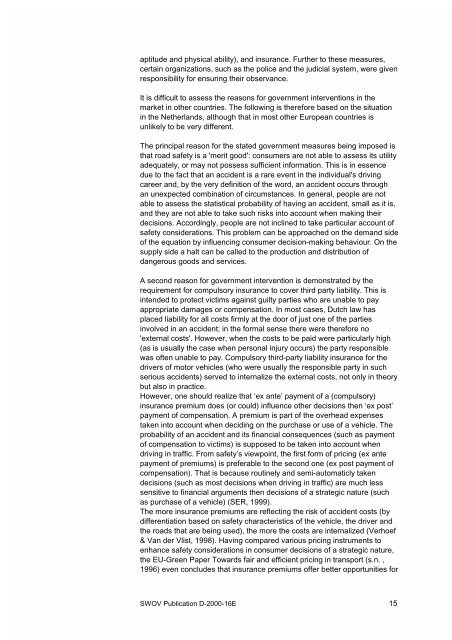Economic evaluation of road safety measures - Swov
Economic evaluation of road safety measures - Swov
Economic evaluation of road safety measures - Swov
You also want an ePaper? Increase the reach of your titles
YUMPU automatically turns print PDFs into web optimized ePapers that Google loves.
aptitude and physical ability), and insurance. Further to these <strong>measures</strong>,<br />
certain organizations, such as the police and the judicial system, were given<br />
responsibility for ensuring their observance.<br />
It is difficult to assess the reasons for government interventions in the<br />
market in other countries. The following is therefore based on the situation<br />
in the Netherlands, although that in most other European countries is<br />
unlikely to be very different.<br />
The principal reason for the stated government <strong>measures</strong> being imposed is<br />
that <strong>road</strong> <strong>safety</strong> is a 'merit good': consumers are not able to assess its utility<br />
adequately, or may not possess sufficient information. This is in essence<br />
due to the fact that an accident is a rare event in the individual's driving<br />
career and, by the very definition <strong>of</strong> the word, an accident occurs through<br />
an unexpected combination <strong>of</strong> circumstances. In general, people are not<br />
able to assess the statistical probability <strong>of</strong> having an accident, small as it is,<br />
and they are not able to take such risks into account when making their<br />
decisions. Accordingly, people are not inclined to take particular account <strong>of</strong><br />
<strong>safety</strong> considerations. This problem can be approached on the demand side<br />
<strong>of</strong> the equation by influencing consumer decision-making behaviour. On the<br />
supply side a halt can be called to the production and distribution <strong>of</strong><br />
dangerous goods and services.<br />
A second reason for government intervention is demonstrated by the<br />
requirement for compulsory insurance to cover third party liability. This is<br />
intended to protect victims against guilty parties who are unable to pay<br />
appropriate damages or compensation. In most cases, Dutch law has<br />
placed liability for all costs firmly at the door <strong>of</strong> just one <strong>of</strong> the parties<br />
involved in an accident; in the formal sense there were therefore no<br />
'external costs'. However, when the costs to be paid were particularly high<br />
(as is usually the case when personal injury occurs) the party responsible<br />
was <strong>of</strong>ten unable to pay. Compulsory third-party liability insurance for the<br />
drivers <strong>of</strong> motor vehicles (who were usually the responsible party in such<br />
serious accidents) served to internalize the external costs, not only in theory<br />
but also in practice.<br />
However, one should realize that ‘ex ante’ payment <strong>of</strong> a (compulsory)<br />
insurance premium does (or could) influence other decisions then ‘ex post’<br />
payment <strong>of</strong> compensation. A premium is part <strong>of</strong> the overhead expenses<br />
taken into account when deciding on the purchase or use <strong>of</strong> a vehicle. The<br />
probability <strong>of</strong> an accident and its financial consequences (such as payment<br />
<strong>of</strong> compensation to victims) is supposed to be taken into account when<br />
driving in traffic. From <strong>safety</strong>’s viewpoint, the first form <strong>of</strong> pricing (ex ante<br />
payment <strong>of</strong> premiums) is preferable to the second one (ex post payment <strong>of</strong><br />
compensation). That is because routinely and semi-automaticly taken<br />
decisions (such as most decisions when driving in traffic) are much less<br />
sensitive to financial arguments then decisions <strong>of</strong> a strategic nature (such<br />
as purchase <strong>of</strong> a vehicle) (SER, 1999).<br />
The more insurance premiums are reflecting the risk <strong>of</strong> accident costs (by<br />
differentiation based on <strong>safety</strong> characteristics <strong>of</strong> the vehicle, the driver and<br />
the <strong>road</strong>s that are being used), the more the costs are internalized (Verhoef<br />
& Van der Vlist, 1998). Having compared various pricing instruments to<br />
enhance <strong>safety</strong> considerations in consumer decisions <strong>of</strong> a strategic nature,<br />
the EU-Green Paper Towards fair and efficient pricing in transport (s.n. ,<br />
1996) even concludes that insurance premiums <strong>of</strong>fer better opportunities for<br />
SWOV Publication D-2000-16E 15
















